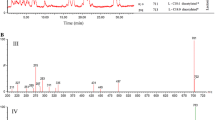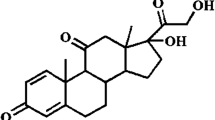Summary
The transformation of hydrocortisone to prednisolone was studied in aqueous two-phase systems, as a model for the extractive bioconversion of fine chemicals. The bacterium, Arthrobacter simplex, was able to grow in the two-phase system and the cells could be revitalized after a period of use. Use of aqueous two-phase systems made it possible to operate the reaction at higher substrate concentrations than in pure buffer solution. An adsorptive method to remove the product from the top phase was tested and shown to be both efficient and compatible with the overall process. In order to reduce the costs of operation in aqueous two-phase systems, a cheaper starch-based polymer, Reppal-PES, was successfully used as a substitute for dextran.
Similar content being viewed by others
References
Adlercreutz P, Mattiasson B (1982) Oxygen supply by hemoglobin or emulsions of perfluorochemicals. Eur J Appl Microbiol Biotechnol 16:165–170
Antonini E, Carrea G, Cremonesi P (1981) Enzyme catalyzed reactions in water-organic solvent two-phase systems. Enzyme Microb Technol 3:291–296
Bhasin DP, Gryte CG, Studebaker JF (1976) A silicone polymer as a steroid reservoir for enzyme-catalyzed steroid reactions. Biotechnol Bioeng 18:1777–1792
Brink LES, Tramper J (1985) Optimization of organic solvent in multiphase biocatalysis. Biotechnol Bioeng 27:1258–1269
Buckland BC, Dunnill P, Lilly MD (1975) The enzymatic transformation of water-insoluble reactants in non-aqueous solvents. Conversion of cholesterol to cholest-4-ene-3-one by a Nocardia sp. Biotechnol Bioeng 17:815–826
Constantinides A (1980) Steroid transformation at high substrate concentrations using immobilized Corynebacterium simplex cells. Biotechnol Bioeng 22:119–136
Kaul R, Adlercreutz P, Mattiasson B, Co-immobilization of substrate and biocatalyst. A method for bioconversion of poorly soluble substances in water milieu. Biotechnol Bioeng (in press)
Kondo E, Masuo E (1961) ‘Pseudo-crystallofermentation’ of steroid: A new process for preparing prednisolone by a microorganism. J Gen Appl Microbiol 7:113–117
Leonhardt A, Szwajcer E, Mosbach K (1985) The potential use of silicon compounds as oxygen carriers for free and immobilized cells containing l-amino acid oxidase. Appl Microbiol Biotechnol 21:162–166
Lilly MD, Woodley JM (1985) Biocatalytic reactions involving water-insoluble organic compounds. In: Tramper J, Van der Plas HC, Linko P (ed) Biocatalysts in organic syntheses. Elsevier, Amsterdam, p 179
Mattiasson B (1983) Applications of aqueous two-phase systems in biotechnology. Trends Biotechnol 1:16–20
Mattiasson B, Hahn-Hägerdal B (1983) Utilization of aqueous two-phase systems for generating soluble immobilized preparations of biocatalysts. In: Mattiasson B (ed) Immobilized cells and organelles. CRC-Press, Florida, Vol I, p 121
Mattiasson B, Larsson M (1985) Extractive bioconversions with emphasis on solvent production. In: Russel GE (ed) Biotechnology and genetic engineering reviews. Intercept, England, Vol 3, p 137
Mattiasson B, Ling TGI (1986) Efforts to integrate affinity interactions with conventional separation technologies. J Chromat 376:235–243
Ohlson S, Larsson P-O, Mosbach K (1979) Steroid transformation by living cells immobilized in calcium alginate. Eur J Appl Microbiol Biotechnol 7:103–110
Puziss M, Hedén C-G (1965) Toxin production by Clostridium tetani in biphasic liquid cultures. Biotechnol Bioeng 7:355–366
Sonomoto K, Tanaka A, Omata T, Yamane T, Fukui S (1979) Application of photocrosslinkable resin prepolymers to entrap microbial cells. Effects of increased gel hydrophobicity on the hydrocortisone 265-1. Eur J Appl Microbiol Biotechnol 6:325–334
Wang HY (1983) Integrating biochemical separation and purification steps in fermentation processes. Ann NY Acad Sci 413:313–321
Author information
Authors and Affiliations
Additional information
Dedicated to Professor Dr. Georg Manecke on the occasion of his 70th birthday
Rights and permissions
About this article
Cite this article
Kaul, R., Mattiasson, B. Extractive bioconversion in aqueous two-phase systems. Appl Microbiol Biotechnol 24, 259–265 (1986). https://doi.org/10.1007/BF00257046
Received:
Revised:
Issue Date:
DOI: https://doi.org/10.1007/BF00257046




